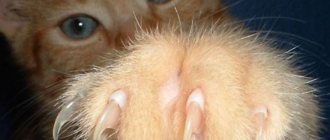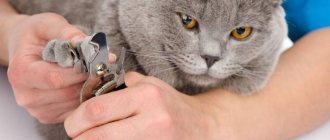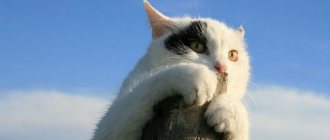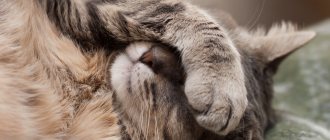Any pet needs hygiene procedures that help maintain a neat appearance and health. One of the mandatory items for caring for a pet is trimming its nails. You should familiarize yourself in advance with how to properly trim a dog’s nails so as not to injure it.
Why trim your dog's nails?
The vast majority of urban four-legged animals spend only a short time on the street. They live most of the day in apartments where slippery parquet, linoleum or soft carpet do not allow the nail plate to wear down to its natural state. Because of this, it grows regularly and problems arise.
Indications for manicure
If the dog does not live on the street, trimming its nails is a mandatory procedure. What are the consequences of not getting a manicure?
- A long claw causes inconvenience when moving. The dog positions its limbs incorrectly, thereby reducing discomfort. Gradually, this provokes curvature, joint diseases and harmful stress on the musculoskeletal system. As a result, any movement will be difficult.
- All dog breeders know that pets have a fifth toe on their hind legs. Sometimes it is removed in infancy, but in most cases it is not given much importance. However, the claw that grows on it must be shortened. If this is not done, the dog will begin to cling to upholstered furniture, bedspreads, and the owner’s clothes, risking injury.
- In the same way, injuries to any other overgrown claws can occur.
- It is possible for the nail plate to grow into soft tissue. This creates severe pain and bleeding.
- When moving on laminate or parquet, your pet makes loud noises, which is especially inconvenient at night. The owner may needlessly scold the pet for making noise when it goes to drink water.
Experienced dog breeders recommend that novice owners consult with a veterinarian or groomer before performing any manipulation. A professional will advise what length to leave, suggest an algorithm of actions and even conduct a master class on trimming.
Structure of a dog's claw
It is necessary to understand the anatomy of the paw and claw in order to do a dog manicure without unnecessary trouble.
An animal's claw has a part with blood vessels and nerve endings called the claw bed. If you touch him, the sensation will be equivalent to cutting off a piece of living skin from a dog. Therefore, you can cut only the overgrown and keratinized part - it is clearly visible in the light. If the fur between your toes interferes with your vision, carefully trim that too.
Different dog breeds have different claw shapes:
- straight (mainly in small indoor breeds);
- arcuate - very dense;
- cat-like, or curved arched.
The cutting principle will remain the same, but tools of different sharpness and shape may be required.
Useful tips
- Long hair between the toes should be trimmed so that it does not get in the way during the procedure. To do this, purchase special scissors with rounded edges. This procedure is performed 1-2 times a month to simplify access to each claw and relieves the dog of the threat of dirt accumulation on the paws and pathogenic microflora in them.
In winter, snow accumulates on the fur between the pads, which is why a dog of small breeds can slip and even scratch its paws until they bleed. The fur between the pads can also become matted, which can make the dog uncomfortable while walking. Hair clipping is the best way to prevent fungal infections that occur in conditions of high humidity.
- The best time to trim nails is when your pet has just returned from a walk or has eaten and is feeling sleepy. In this state, he will not resist much.
- The most important thing to do before trimming nails is to make sure that the dog is in a good mood and not stressed. If the dog has never had its nails trimmed before, on the day of the scheduled procedure you should sit next to it several times and, clicking the nail clipper, talk to it affectionately. The animal must understand that this tool does not pose any danger .
- Remember : the procedure for trimming nails should be associated with positive, not negative emotions for the dog. To make nail trimming enjoyable for your pet, stock up on his favorite treat before the procedure. And don’t forget to praise and pet your dog in between.
How to train a dog to trim its nails
Breeders with many years of experience and veterinarians believe that there is nothing complicated in the procedure itself if the animal has been accustomed to it since childhood. But the process of getting used to manicure becomes a difficult ordeal for most, so it’s worth preparing in advance and knowing what awaits you and your pet.
You need to get down to business in a state of calm. The dog will instantly feel nervous excitement, stress or anger of the owner and will also experience unpleasant sensations. The pet will not understand the reason for such feelings, but will begin to worry, twitch, and break free from the person’s hands. This will significantly complicate the procedure.
You should introduce your pet to the grooming procedure without haste. When the four-legged animal is in a calm, even relaxed state (after a walk and food), you should lift its paw, try it on and cut off a small tip - as if conducting a test. You should not force the animal or do it with effort and fuss. After the first success, you need to praise your pet: treat it with a tasty piece, scratch it, hug it. Having worked and consolidated the positive sensations, you can move on to the next claw.
If the dog has already had a negative experience with a manicure, then the situation will be much more complicated. Your four-legged friend will begin to get nervous just at the sight of tools, will not want to give you a paw, and may run away and hide. Then the algorithm of actions will be as follows:
- Show tools and equipment to your pet and let them sniff. Then you need to put everything back in place. This must be done several times so that the dog gets used to them and sees that they are not dangerous in your hands.
- Then the pet must give the owner a paw, and the owner must touch the limb with a nail clipper. This will make it clear that there is nothing wrong with manipulation. There is no need to cut it yet - let the dog get used to it a little longer.
- Before trimming your dog’s nails, it is important to clean your hands and disinfect your tools. The animal’s limbs must also be clean, which means it must be accustomed to the unusual smells of disinfectants.
- If you have other pets who are not afraid of nail trimming, you can use their example to demonstrate to your timid pet that there is nothing terrible in the procedure. In front of the dog, give a manicure to a cat or another dog, praise it and release it.
- A calm dog is called and one nail is shortened. They act very carefully so as not to cause pain or discomfort. After this, he is praised, treated and released to do his own thing.
At the very beginning, the process takes quite a lot of time. Sometimes it takes a whole day to finish one nail. But as soon as your four-legged friend gets used to the process, you can do everything at once.
Alternative to a haircut: is there one?
Most veterinary clinics offer the procedure - onychectomy, but how humane it is has long been discussed and condemned not only by doctors, but also by breeders who previously agreed to perform the operation on a cat. Onychectomy is nicely called “soft paws”, but in reality it is a complex, bloody and unreasonably difficult psychological procedure.
In essence, this is the removal of the first phalanx of fingers with claws. Each owner can actually try on what it looks like, imagining the amputated part of the hand on their own hands. The damage to furniture stops, but the animal experiences severe psychological shock, since the need to defend itself, sharpen and cling does not go away.
The second most popular are anti-scratch silicone tips of different colors. They are attached with special glue. A cat's manicure looks glamorous; the animal stops sharpening its claws on furniture, but this greatly affects their ability to climb and walk. In addition, multi-colored caps do not eliminate the problem - the claws underneath them still grow and need to be trimmed periodically.
Specialists of the RosVet VC do not approve of onychectomy as a whim of the owner. The operation is possible only according to indications, when there is severe injury to the fingers and it is impossible to save the phalanx. Caps are a less dangerous method, but also suppress the cat's natural instincts. The solution is to provide your pet with a place to grind down its claws or regularly visit the veterinary clinic to have its claws trimmed. You can sign up for the procedure by phone: + 7 (495) 256-11-11, around the clock.
How often do you trim a dog's nails?
It is impossible to answer this question unequivocally: the frequency depends entirely on what kind of life the pet leads. If the dog lives in a comfortable city apartment, walks in a diaper or in a litter box, runs on laminate, parquet, linoleum, carpet, then the nail plate should be trimmed quite often - as it grows.
An active pet that spends a lot of time outdoors, running and playing on hard asphalt, is cut much less often. Thanks to walks, the claws wear down on their own, and the owner only needs to make a small correction.
It’s not difficult to understand that it’s time for a haircut: the pet begins to cling to textiles in the house. Then you need to trim your claws. Another way is to visually assess the condition of the claw, which is what more experienced dog breeders usually do.
Veterinarians remind us that there are blood vessels under the hard surface. The length of the vessels depends on the length of the plate. Therefore, it should not be allowed to grow to an excessive size, otherwise in advanced cases it will become almost impossible to remove part of the claw without damaging the vessel.
Where to cut: at home or at the groomer?
If you regularly get your pet's hair done at a grooming salon or with a specialist, it makes sense to trust the same groomer to do the manicure. You won't have to take your pet anywhere anymore.
If your dog does not require visits to the hairdresser, you can trim its nails at home. It will be cheaper and faster.
Some individuals prefer to behave calmly only with a professional, but with the owner they become uncontrollable. In this case, there is only one way out: take the stubborn dog to the groomer. You can call him to your home - it will be a little more expensive, but it will save time and effort.
If you have never had a dog and you have no idea how to trim a dog’s nails at home, you can go to a salon the first time or two and see how it’s done. And then act independently.
If it doesn't give and bites
But what to do if your dog is absolutely afraid of cutting his nails, or if he bites? In this case, before trimming the nails, a large or medium-sized dog should be tied to something that the dog cannot move. Put on a muzzle or wrap a bandage around the dog's face, but so that it can breathe freely.
A small dog can be swaddled in a towel or a small thick blanket. Only one paw and the tip of the muzzle should remain outside. When carrying out the nail trimming procedure, the dog must be held tightly so that it does not break free and fall or run away.
There is also another simple way: take the dog in your arms, turn it over on its back, and cut it calmly; it is not difficult to restrain a struggling dog; on its back, they are practically defenseless and powerless.
Be sure to praise your dog and give him treats! Do a couple of dress rehearsals as well: e.g. Prepare everything for the grooming and let the dog feel the moment and get used to the tools. There is no need to cut your hair the first 2-3 times, just “rehearse.”
Required Tools
Experts do not recommend using ordinary scissors and clippers intended for humans. You can purchase a special nail clipper at pet stores and veterinary pharmacies. The tool is very convenient to use because one click is enough to remove excess length without damaging the surface of the plate. Store salespeople will help you choose the right tool, focusing on the size, shape of the claw and breed.
There are two types of nail clippers:
- Scissors-nippers - a design with two blades has different shapes: one is curved into a hook, the other is straight. The tool is equipped with two non-slip handles. Some models have limiters.
- A guillotine is a tool with one plate, which has a hole for a claw and a handle in the form of a lever. The guillotine is more dangerous, so it is rarely used at home - rather, it is a tool for professionals.
The owner should have several more devices at his disposal. So, a file is needed to trim cuts - you can use a rough model for human manicure. Small scissors with rounded edges will help remove hair between your fingers. Hydrogen peroxide, cotton pads and cotton swabs are needed to treat the emerging wound without interrupting the haircut.
All instruments are wiped with alcohol or peroxide immediately before the procedure, and hands are washed with soap. The animal should also disinfect its paws - lubricate them with peroxide or chlorhexidine.
What should you buy?
The selection at veterinary stores can be confusing, but making a list ahead of time will help you stay organized and get everything you need. This way you will stock up only on the goods you need and will not waste money.
For a good dog pedicure, you don’t have to buy half the pet store.
Table 1. Tools needed to trim a dog's nails
| Item | Description |
Claw cutter | These scissors look like pruning shears. They have 2 handles and 2 blades. They are suitable for small breeds, but they are not always suitable for large dogs with hard claws. |
Guillotine | A tool that has slots to accommodate the claw. Thanks to the levers, a process is launched during which the claw is cut off. This device is suitable for dogs of any breed. The main thing is to choose the hole size |
File | In addition to the cutting device, you will need nail files. A carelessly cut claw can peel or even break. Files will allow you to round it and smooth out unevenness. |
Files can be either manual or electric. They come with several attachments that vary in level of hardness. By inserting the nozzle into the device and turning it on, you will see how the head begins to rotate very quickly. With this tool you can polish the claw, giving it the desired shape.
How to properly trim a dog's nails with a nail clipper
The manipulation of shortening the claw should take place with minimal discomfort for the pet. To prevent the procedure from causing unnecessary anxiety, it is important to know the sequence of actions:
- Inspect both paws for cracks, scratches and damage to the pads. If there is any of the above, the manicure should be postponed until the wound is completely healed. A split nail will require a visit to your veterinarian to prescribe medication.
- You need to place the dog’s leg on the floor, and place the nail clipper at an angle of 45 degrees and set it 1.5-2 mm from the tip. You should cut off no more than 0.5 cm as a maximum - the length of the removed part depends on the size of the dog. The black plate should be cut no more than 0.5 cm at a time. If a light area appears, you must stop immediately. Well-trained dogs can give a paw so that the owner can trim their claws while hanging.
- The cut occurs by pressing the handles of the nail clipper. You need to press sharply, but without unnecessary effort, without jerking your paw.
- Next, you should process the uneven edges with a nail file, taking the dog’s paw in your hand. In case of a cut, moisten the wound with hydrogen peroxide.
Black claws are considered the most difficult to trim. On beige and light-colored claws, it is easy to see blood vessels, which will greatly facilitate the process. The pulp appears as a darker area.
You can see the approximate location of the pulp with blood vessels on the black claw by the location of the hollow. Sometimes the depression is on the side. Veterinarians advise focusing on the hollow and pruning very carefully, not trying to cut everything off at once.
First aid for injuries
Despite full compliance with the rules and compliance with the operating algorithm, even an experienced owner can make a mistake. This can be caused by various circumstances: a sharp sound outside the window, a dull nail clipper, or excessive nervousness of the pet. Don't get upset - it's important to remain calm, apologize to the dog and treat the wound.
Pulp cut
Trimming too short greatly increases the risk of damaging blood vessels. This causes severe pain and excessive bleeding. The main task of the owner in case of pulp injury is to urgently stop the bleeding. In addition, it is necessary to calm your four-legged friend - his reaction will be panic and a desire to run away.
The owner should try to distract the animal, switch its attention to something else - perhaps to a toy or a pre-prepared treat. There is no point in screaming at this moment, as the dog is already scared and in pain. Next you need to treat the wound with hydrogen peroxide. It is not recommended to use alcohol-based solutions - they will only increase the pain and cause a burning sensation.
Antiseptic powder has a good effect. Veterinarians advise having this drug in your pet first aid kit. It is used to treat open wounds and abrasions and copes well with injuries caused during trimming of the nail plate.
Claw detonation
A similar nuisance arises in the case of nervous and uncertain actions of the dog breeder. The dangerous combination of slow compression of the nail cutter along with an unexpected and sharp jerk of the limb during shortening leads to a poor result. Damage to the skin and soft tissues is accompanied by severe pain and fear, and not only from the dog - the owner also experiences nervous shock. However, you should gather your strength and provide first aid to the victim:
- Try to keep the animal in place. Don't shout, but be assertive and speak confidently.
- Next, you need to bandage the injured limb near the metatarsus with a tourniquet or bandage. It is advisable to lift the paw up to stop the bleeding.
- Cold is applied to the damaged surface. You can use an ice pack or frozen food for this.
- Open wounds must be treated with lidocaine or novocaine.
- Sometimes the damage is very severe, so the tear must be stitched. Only a veterinarian can do this.
When transporting an animal to a veterinary clinic, cold should be applied to the damaged area, but at the same time avoid frostbite of the limb.
If there is blood
In this case, you need to take potassium permanganate powder and generously sprinkle it on the wound, or you can use any other hemostatic agent. As a rule, after this the bleeding stops almost immediately. When using potassium permanganate, in order to avoid poisoning, which can happen if the pet accidentally licks it off, after stopping the bleeding, it is necessary to remove all remnants of manganese powder from the dog’s fingers and claws, without touching the cut itself.
There is no need to do anything else with the wound, but be prepared for the fact that if the pulp has been damaged, the dog will limp for some time.
If the wound visually looks dangerous, then wrap the paw in a clean towel, apply ice and go to the vet without hesitation.
ATTENTION ! Any injury during nail trimming is a sign that the procedure should be stopped immediately!











